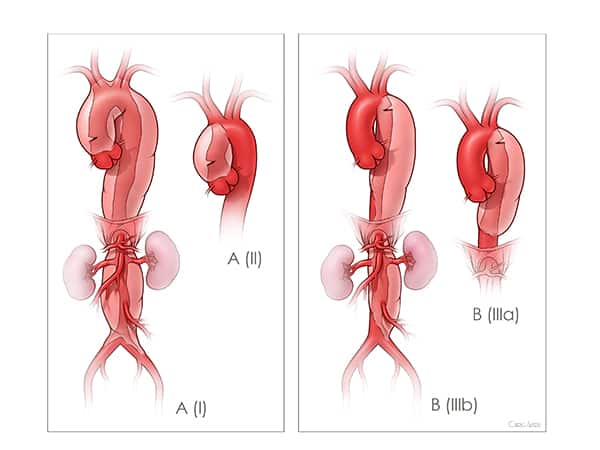- Aortic Disease
- Aortic Dissection
Aortic Dissection
What is Aortic Dissection?
Aortic dissection occurs in the aorta, the main artery in the body that supplies oxygenated blood to the rest of the body. The walls of the aorta consist of three layers, and an aortic dissection happens when there is a tear in the innermost layer. Blood enters between the inner and middle layers of the aortic wall, which causes a false lumen. Aortic dissection can be harmless, serious, or life-threatening. The dissection can compromise the blood flow to the rest of the body, causing severe pain and life-threatening internal bleeding as a result of rupture.
There are two types of aortic dissection: type A and type B.
Type A Aortic Dissection (ascending) occurs when there is a tear in the ascending section of the aorta, where the aorta branches off from the heart. It requires emergency treatment, typically surgical, since there is an increased risk of rupture and heart attack.
Type B Aortic Dissection (descending) occurs when there is a tear in the descending section of the aorta, in the chest or abdomen, which supplies blood to essential organs and supports overall function of the body. Type B dissection is usually managed medically but may need endovascular treatment in the setting of compromising blood supply to the organs.

Symptoms of Aortic Dissection
Patients usually experience acute tearing pain, which is the most common symptom. Chest pain is common in type A dissection while back pain is common in type B dissection. The patients should seek medical attention from a cardiac and vascular specialist immediately. Other common symptoms include:
- Moderate to severe chest or back pain
- Sweating
- Shortness of Breath
- Loss of consciousness
- Leg pain and weakness
While not all of the above symptoms indicate aortic dissection, it is important to be proactive in seeking medical attention, as aortic dissection can cause severe illness or death. In the event the pain is severe, the patient should go immediately to an emergency room.
Diagnosis for Aortic Dissection
Medical imaging is the most common means of diagnosis of aortic dissection; a CTA (Computed Tomography Angiogram) is considered the industry’s gold standard. Traditional CT scans, MRIs, and echocardiograms can also help detect aortic dissection.
Treatment for Aortic Dissection
Pending the severity of the condition and type of dissection (A or B), a trained aortic specialist will help determine best treatment option(s). Treatment options range from no intervention, medication, or to surgical repair. Lifelong monitoring of the aortic dissection is necessary, even after treatment.
Surgical treatment options include minimally invasive procedures, or standard open repair. Surgical treatment is intended to reconstruct or replace the affected area of the aorta. Such surgical procedures include the placement of a stent or stent graft, which can be placed through open repair, endovascular repair (minimally invasive), or a hybrid approach combining the two. The most common treatment modalities are open repair of ascending aorta for type A dissection, and thoracic endovascular aortic repair (TEVAR) for type B dissection.
The aortic dissection is usually associated with uncontrolled high blood-pressure. It is important to monitor blood pressure and to control it. Medications, such as beta blockers, are common treatment options to manage the condition, though other medications may be prescribed.


